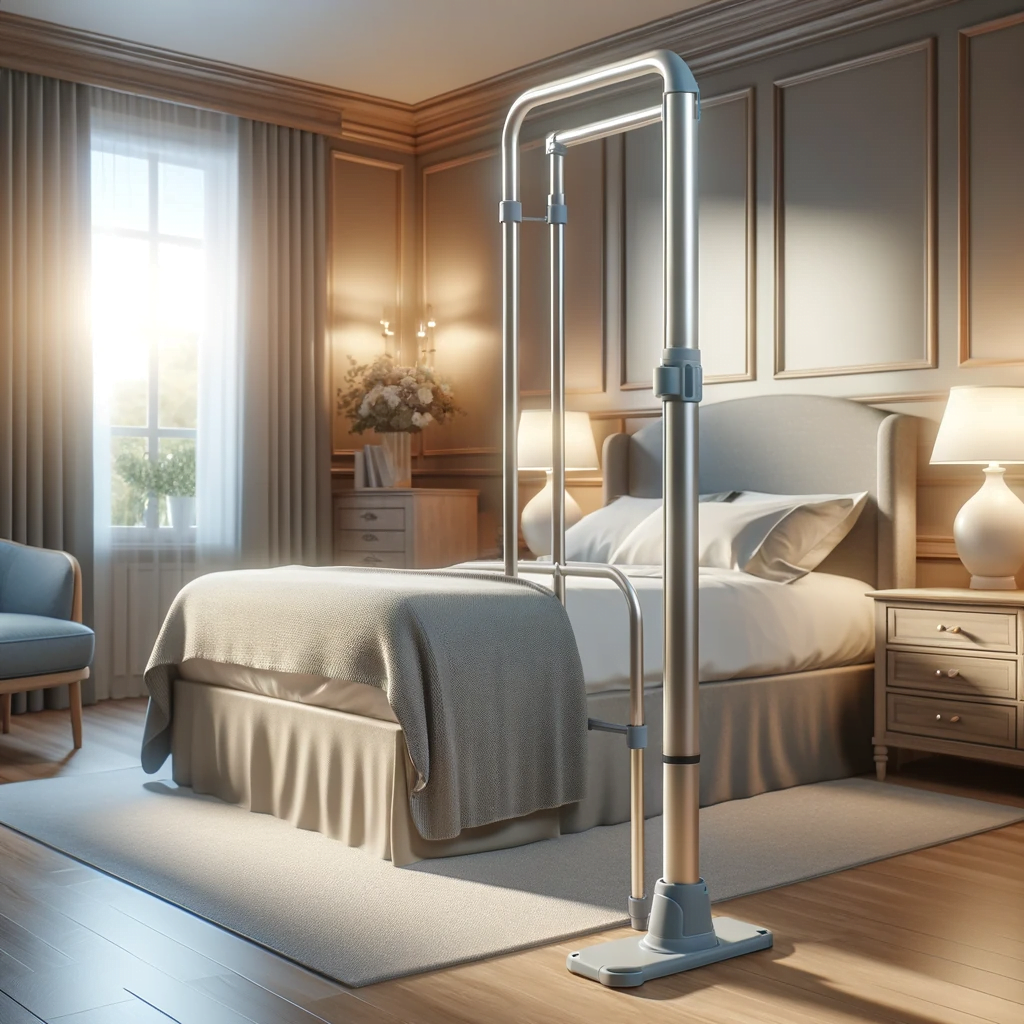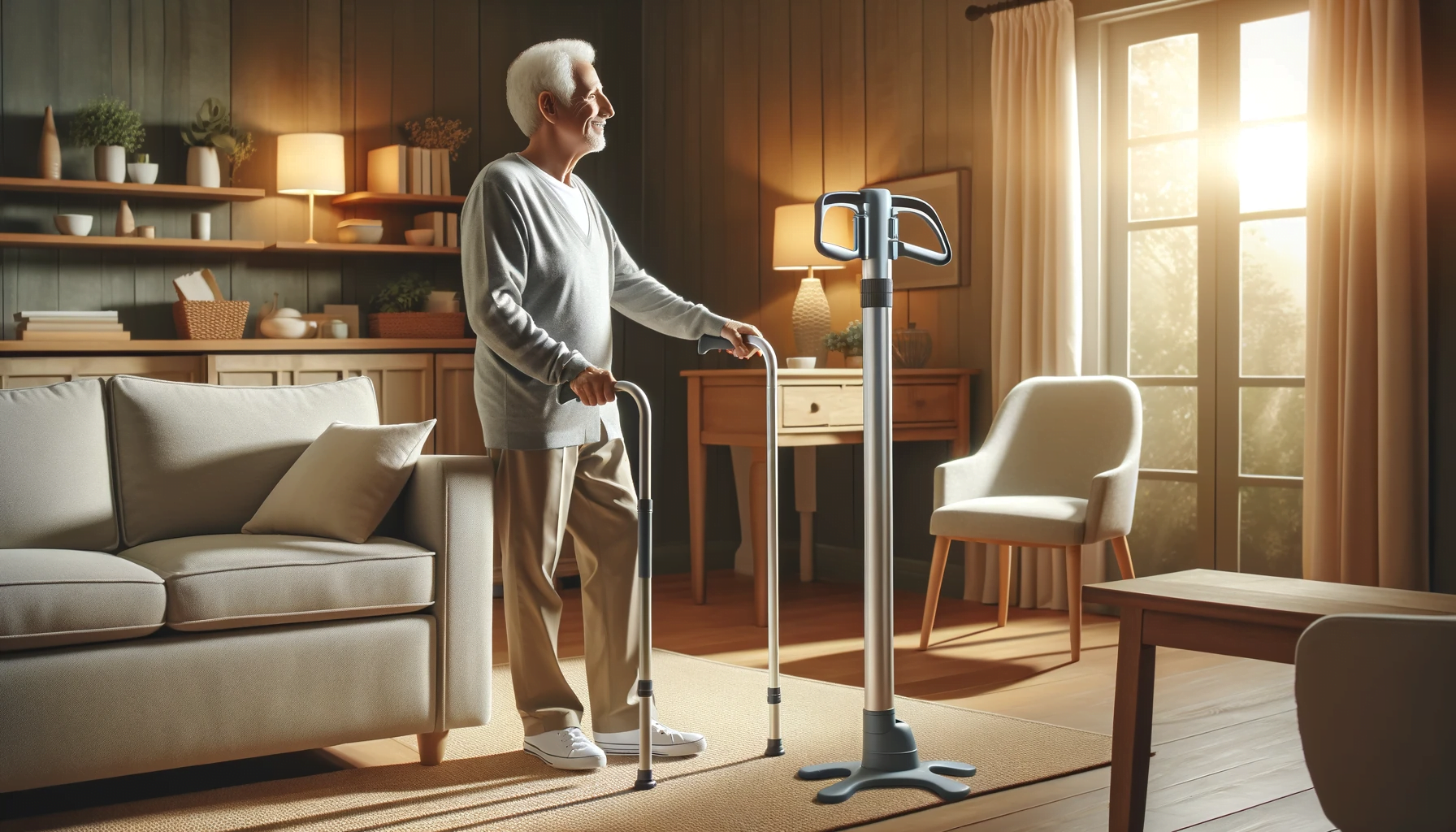Transfer Poles for Senior Care – 2024 Informative Guide
Introduction to Transfer Poles
Transfer poles, also known as security poles or grab poles, have become an indispensable tool in senior care. These poles are designed to aid seniors with limited mobility, helping them move safely from sitting to standing positions, and vice versa. Their significance in ensuring the safety and independence of our elderly loved ones cannot be overstated.
The Evolution of Transfer Poles
The concept of transfer poles has evolved significantly over the years. Originally simple, fixed structures, they have transformed into sophisticated aids equipped with adjustable features and ergonomic designs. This evolution reflects a deeper understanding of the mobility challenges faced by seniors and the technological advancements aimed at addressing these challenges.
Essential Features of Transfer Poles
Transfer Poles Components and Materials
Transfer poles are typically made from sturdy materials like steel or aluminum, ensuring durability and the ability to support significant weight. The safety of these poles is paramount, with many featuring non-slip grips and floor-to-ceiling tension for added stability. Their construction is a testament to the importance of quality and reliability in senior care products.
Transfer Poles Design Variations
The market offers a variety of transfer pole designs to cater to different needs and preferences. Some poles come with additional features like swivel handles or horizontal bars, while others are more simplistic in design. This variety ensures that there is a suitable option for every senior’s specific situation, whether it’s for use in the bathroom, bedroom, or living room.
Different Types of Transfer Poles
Transfer poles, an essential aid in senior care, come in various types to cater to different needs and environments. Understanding these variations is crucial in selecting the most appropriate one for a specific situation. Here we discuss the common types of transfer poles, highlighting their unique features and applications.

Standard Transfer Poles
The standard transfer pole is the most basic type, designed for general use. It typically features a simple, sturdy pole with a non-slip grip. These poles are often tension-mounted, meaning they can be securely installed between the floor and ceiling without the need for drilling. Ideal for use in bedrooms or living areas, standard poles provide reliable support for standing, sitting, or transferring from one position to another.

Transfer Poles with Handles
Some transfer poles come equipped with handles, which can be particularly beneficial for seniors needing extra leverage. These handles often swivel and lock in place, providing additional support and flexibility in movement. This type is especially useful for individuals with more specific mobility challenges, as the handles offer a more secure grip.
Floor-to-Ceiling and Floor-to-Wall Poles
While most transfer poles extend from floor to ceiling, there are models designed to extend from floor to wall. These are particularly useful in rooms where ceiling height might be an issue or in areas where a ceiling mount is not feasible. They provide the same level of stability and support as traditional poles but offer more flexibility in terms of placement.
Portable Transfer Poles
Portable transfer poles are designed for temporary or on-the-go use. They are lightweight, easy to disassemble, and can be transported for use in different locations, such as during travel or staying in hotels. While they may not offer the same level of sturdiness as permanent poles, they are an excellent option for short-term needs.

Heavy-Duty Transfer Poles
Heavy-duty transfer poles are made to support higher-weight capacities and are often constructed with reinforced materials. These poles are ideal for bariatric patients or individuals who require extra support. Despite their robust construction, they are still designed with ease of use and comfort in mind.
Customizable Transfer Poles
Some transfer poles offer customization options, such as adjustable heights, interchangeable handles, or additional accessories like horizontal bars. These customizable features allow for a more personalized setup, catering to the unique needs and preferences of the user.
Each type of transfer pole has its unique advantages and is designed to cater to different requirements and physical conditions. When choosing a transfer pole, it’s important to consider the specific needs of the senior, the intended use, and the environment where it will be installed. By understanding the different types of transfer poles available, caregivers and seniors can make an informed decision that ensures safety, comfort, and enhanced mobility.
The Benefits of Transfer Poles for Seniors
Enhancing Mobility and Independence
Transfer poles significantly aid in mobility, enabling seniors to move more freely and with less assistance. This not only fosters a sense of independence but also contributes to the physical well-being of the elderly by encouraging movement and reducing sedentary behavior. These poles are a bridge to a more active and self-sufficient lifestyle for many seniors.
Safety and Security
One of the primary benefits of transfer poles is their role in minimizing the risk of falls and injuries, which are a major concern in senior care. The psychological impact of having a reliable support system within reach cannot be understated, as it instills a sense of security and confidence in seniors while performing daily tasks.
Choosing the Right Transfer Pole
Factors to Consider
When selecting a transfer pole, several factors must be considered. The size and layout of the room, the senior’s weight, and the pole’s adjustability are crucial elements. It’s important to choose a pole that not only fits the space but also meets the specific needs of the user in terms of support and ease of use.
Installation and Maintenance
Installing a transfer pole is a straightforward process, but it must be done correctly to ensure safety. Regular maintenance, such as checking for loose components and ensuring the pole remains securely fastened, is essential for its longevity and effectiveness. These practical aspects are vital for the continuous support and safety of seniors.
Comparing Transfer Poles with Other Mobility Aids
Transfer Poles vs. Other Aids
When considering mobility aids for seniors, it’s crucial to understand how transfer poles stack up against other common aids such as walkers and grab bars. Each of these aids serves a unique purpose and offers specific benefits, making them more or less suitable depending on the individual needs and circumstances of the senior.
Transfer Poles: Features and Benefits
Transfer poles, often floor-to-ceiling structures, provide a stable grip for seniors to pull themselves up from a seated position or offer support while standing. Their key features include:
- Versatility in Placement: This can be installed in various locations throughout the home, including beside the bed, near the toilet, or in the living room.
- Continuous Support: Offer support along the entire length, which is beneficial for seniors who require steady assistance while standing or changing positions.
- Minimal Space Requirement: Occupying very little floor space, they are ideal for smaller rooms where larger aids cannot fit.
Walkers: Features and Benefits
Walkers are portable frames without wheels or with wheels that provide support while walking. Their main features include:
- Enhanced Mobility: Ideal for seniors who can walk but need support, especially those with balance issues.
- Portability: Easily movable, allowing seniors to use them both indoors and outdoors.
- Variety of Designs: Range from simple, lightweight frames to models with wheels, seats, and handbrakes.
Grab Bars: Features and Benefits
Grab bars are fixed supports installed in specific areas like bathrooms and hallways. They offer:
- Targeted Support: Provide support in high-risk areas such as the shower or near the toilet, where seniors are more prone to slips and falls.
- Durability: Often made of stainless steel or other sturdy materials, they are designed to support a significant amount of weight.
- Custom Placement: Can be installed at various heights and positions, tailored to the specific needs of the user.
Comparing the Aids
- Stability vs. Mobility: Transfer poles offer continuous, stationary support, making them suitable for seniors who need help standing or transferring from one position to another. Walkers, on the other hand, are designed for moving around, catering to those who are mobile but require additional support.
- Space and Installation Requirements: Transfer poles require a stable ceiling and floor for installation, while grab bars need solid walls. Walkers require no installation and are useful in various settings.
- User Independence: Transfer poles and grab bars promote independence in specific activities, such as getting in and out of bed or using the bathroom. Walkers assist with general mobility, allowing seniors to move around more freely.
- Application Areas: Transfer poles are versatile but are mostly used indoors. Walkers are suitable for both indoor and outdoor use, whereas grab bars are specifically for areas where there’s a risk of slipping or falling.
In summary, the choice between transfer poles, walkers, and grab bars should be based on the senior’s specific mobility needs, physical condition, and the environment in which they will be used. A combination of these aids might be the best approach to ensure comprehensive support for the senior’s daily activities.
Making an Informed Decision
Purchasing Guide to Transfer Poles
Choosing the right transfer pole involves careful consideration of various factors. This guide provides tips on what to look for, such as weight capacity, height adjustability, and ease of installation. Links to resources and various sellers are also provided to assist in the purchasing process.
Summary and Final Thoughts
In conclusion, transfer poles are a crucial component of senior care, offering mobility support, safety, and independence. This article has covered the key aspects of transfer poles, from their evolution and design features to user experiences and maintenance tips. We hope that this information will guide you in making an informed decision, ensuring the well-being and comfort of your loved ones.

